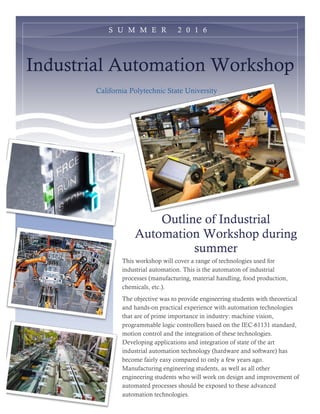
Automation
- 1. Industrial Automation Workshop California Polytechnic State University Outline of Industrial Automation Workshop during summer This workshop will cover a range of technologies used for industrial automation. This is the automaton of industrial processes (manufacturing, material handling, food production, chemicals, etc.). The objective was to provide engineering students with theoretical and hands-on practical experience with automation technologies that are of prime importance in industry: machine vision, programmable logic controllers based on the IEC-61131 standard, motion control and the integration of these technologies. Developing applications and integration of state of the art industrial automation technology (hardware and software) has become fairly easy compared to only a few years ago. Manufacturing engineering students, as well as all other engineering students who will work on design and improvement of automated processes should be exposed to these advanced automation technologies. S U M M E R 2 0 1 6
- 2. 2 THE LOREM IPSUMS SUMMER 2016 Applications Students should learn to deal with: • Programmable logic controllers (PLC) including programming with ladder logic, block diagrams and structured text • Servo-motor control • Stepper motor control • Machine vision and image processing • Industrial robot programming During the past ten years, manufacturing automation has changed dramatically. Developments in software and new standards allow rapid development and integration of sophisticated automation applications. It is possible now to develop applications that require integration of machine vision, programmable logic controllers, control of multi-axis servomotors, and robot manipulators from multiple vendors in a fairly short amount of time. It has become an accepted technology with many successful industrial applications. These changes have occurred due to several factors: the growth in computing processor power and speed, growth in memory capacity, significant cost reduction of computer and machine vision technologies, the availability of powerful and easy-to- use PLC, machine vision and motion control software tools, and the development of industry standards such as the IEC 61131. There is much interest in industry to recruit talented engineers with knowledge of automation of products and processes. It is important to distinguish the difference between engineers who may work in automation of products, known as mechatronics or embedded computers, and engineers who may work on automation of processes, known as factory automation. There are similarities in the body of knowledge for both of these automation engineers, and both are very much in demand. The difference between engineers who work in automation of products (mechatronics) and automation of processes, becomes evident when we look into the development cost, number of copies into which the automation will be implemented and cost per unit. When developing an automated product, for example a refrigerator that is “internet ready”, the cost of development and cost of hardware will be prorated among many thousand copies of the product, so the cost per unit will be small enough to be attractive to consumers and competitive. When developing an automated process or production line, it is likely that there will be one or very few productions lines, but what is important is that the development of the automated system is completed in a short time, is robust, reliable, safe, easy to integrate to existing networks, easy to repair, and easy to modify. This paper is concerned with developing a sequence of two courses and laboratory experiences to prepare engineering students for the automation of processes and production lines.
- 3. 3 THE LOREM IPSUMS SUMMER 2016 Lab Facilities There are 12 workstations in the laboratory, which can accommodate up to 24 students working in teams of two students per workstation. We have at least twelve copies of all the equipment available in the laboratory. Rockwell Automation (Allen Bradley) CompactLogix PLC Trainer Yaskawa 2-Axis Servo-Motor Control Trainer Keyence Machine Vision Controller and CompactLogix PLC Keyence Cameras for Machine Vision System Pneumatic Cylinder Control Trainer Setup Linear Slide with Rockwell Automation Kinetix Servo-Motor
- 4. 4 THE LOREM IPSUMS SUMMER 2016 Contents Lecture: Introduction to automation and PLC’s. Safety. Lab: Programming PLC using ladder logic Lecture: State-machine diagrams Lab: Use of timer and counters. Pneumatics Converting a state-machine diagram into a PLC program Lecture: Stepper motors and servomotor control Lab: Programming motion with servomotors Lecture: Machine vision and image processing concepts Lab: Programming a machine vision system Lecture: Machine vision (continued). Safety Lab: Machine vision and image processing. Robotics. Students’ projects Students may be asked to develop a project in which they are expected to apply concepts learned in this class. All projects are self-selected. Students are encouraged to generate their own ideas for a project and to discuss these ideas with the instructors. There are some benefits as well as potential difficulties of this approach which instructors should be aware. The biggest benefit of self- selected projects is the high level of enthusiasm and motivation of the students once they start working on their project ideas. Students should make their project idea work and will come to the lab more frequently to ensure the success of their project. A potential difficulty is that students unfamiliar with the technology may find it difficult to select a project idea. If the indecision is carried too far into the term, there may not be adequate time to develop or complete a quality project. Providing examples of project ideas, especially past projects for the same class, allows students to more easily move forward. Student Project - Inspection of sliced apples to detect if they have seeds Student Project – Copy machine to reproduce an image Student Project – when all five fingers are detected, it directs a servomotor to move a cardboard hand to give a “high five”.